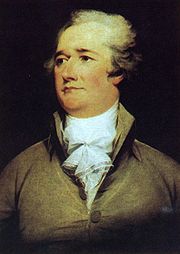
Federalist No. 33
Encyclopedia

Alexander Hamilton
Alexander Hamilton was a Founding Father, soldier, economist, political philosopher, one of America's first constitutional lawyers and the first United States Secretary of the Treasury...
, the thirty-third of the Federalist Papers
Federalist Papers
The Federalist Papers are a series of 85 articles or essays promoting the ratification of the United States Constitution. Seventy-seven of the essays were published serially in The Independent Journal and The New York Packet between October 1787 and August 1788...
. It was published on January 2, 1788 under the pseudonym
Pseudonym
A pseudonym is a name that a person assumes for a particular purpose and that differs from his or her original orthonym...
Publius, the name under which all the Federalist Papers were published. This is the fourth of seven essays by Hamilton on the then-controversial issue of taxation. It is titled, "The Same Subject Continued: Concerning the General Power of Taxation."
Summary
Hamilton notes that the Necessary and Proper Clause and the Supremacy ClauseSupremacy Clause
Article VI, Clause 2 of the United States Constitution, known as the Supremacy Clause, establishes the U.S. Constitution, U.S. Treaties, and Federal Statutes as "the supreme law of the land." The text decrees these to be the highest form of law in the U.S...
"have been the source of much virulent invective and petulant declamation against the proposed Constitution." He argues that the first clause is implicit in the constitution—if congress is granted a power, it must necessarily be able to draft laws that enable it to execute that power. Hamilton then applies this line of logic to the issue of taxation, stating that Congress must have the power to create legislation to collect taxes.
He poses the question of why the clause should be included, if its power is implicit? He answers by saying that the clause is included "to guard against all cavilling refinements in those who might hereafter feel a disposition to curtail and evade the legitimate authorities of the Union," in other words, to guard against those who would seek to evade the authority of the Union by an overly literal interpretation of the constitution.
His response to a potential abuse of these powers is that the government must be responsible for the proper exercise of its powers, but ultimately the people themselves must hold the governnment to account. "If the federal government should overpass the just bounds of its authority and make a tyrannical use of its powers, the people, whose creature it is, must appeal to the standard they have formed, and take such measures to redress the injury done to the Constitution as the exigency may suggest and prudence justify."
Hamilton similarly argues that the Supremacy Clause
Supremacy Clause
Article VI, Clause 2 of the United States Constitution, known as the Supremacy Clause, establishes the U.S. Constitution, U.S. Treaties, and Federal Statutes as "the supreme law of the land." The text decrees these to be the highest form of law in the U.S...
is simply an assurance that the government's powers can be properly executed, saying that a law itself implies supremacy, and without supremacy it would amount to nothing. He returns to the example of taxation, stating that the supremacy of the constitution as the law of the land did not preclude states from independently raising their own taxes as necessary, except for duties on imports and exports.
Hamilton concludes by saying that this concurrent jurisdiction in the realm of taxation was the only acceptable substitute to complete federal control, an idea he expounds upon in Federalist No. 34
Federalist No. 34
Federalist No. 34 is an essay by Alexander Hamilton, the thirty-fourth of the Federalist Papers. It was published on January 5, 1788 under the pseudonym Publius, the name under which all the Federalist Papers were published. This is the fifth of seven essays by Hamilton on the then-controversial...
.

